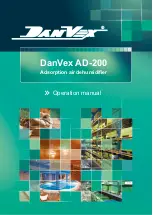
6
CLIMIA
With regard to energy consumption,
air dehumidification has one
distinct advantage:
Energy expenditure is limited
exclusively to the air volumes
present. The mechanical heat that
is released by the dehumidification
process is fed back into the room.
Under normal use, the air
dehumidifier uses
approximately 25% of the
energy that is required for
the "heating and ventilating"
principle.
Relative air humidity
Our ambient air is a gaseous
mixture which always contains
a certain volume of water in the
form of water vapour. This volume
of water is specified in g per kg of
dry air (absolute moisture content).
1m
3
of air weighs approx. 1.2 kg
at 20°C
Depending on the temperature,
each kg of air is only capable of
absorbing a certain volume of
water vapour. Once this capacity
has been reached, the air is referred
to as “saturated” and has a relative
humidity (RH) of 100 %.
Relative humidity is understood to
mean the ratio between the current
quantity of water vapour in the air
and the maximum possible quantity
of water vapour at the same
temperature.
The ability of the air to absorb water
vapour increases as the temperature
rises. I.e. the maximum possible
(absolute) water content becomes
greater as the temperature rises.
Building materials and structures
are capable of absorbing
considerable volumes of water,
such as brick 90-190 l/m³, heavy
concrete 140-190 l/m³ and
limestone 180-270 l/m³.
The drying of moist materials such
as masonry is effected as follows:
•
The moisture moves
from the inside of
the material to its
surface
•
Evaporation occurs on the
surface = Transfer of water
vapour to the ambient air
•
The air containing water vapour
is constantly circulated through
the air dehumidifier. The air
is dehumidified and, slightly
heated, leaves the unit in order
to re-absorb water vapour
•
In this way, the moisture
contained in the material is
reduced gradually.
The material is dried!
The accumulated condensate is
collected in the unit and drained off
from there.
Drying materials
% RH
Evaporator
Condenser
Air temperature
Air direction
Air humidity
Progression
As it flows through or over the evaporator, the air stream is cooled to dew
point. The water vapour condenses, and is collected in a condensate trap
from where it is drained off.
Temp.
Water vapour content in g/m
3
at humidity of
°C
40%
60%
80%
100%
-5
1.3
1.9
2.6
3.3
+10
3.8
5.6
7.5
9.4
+15
5.1
7.7
10.2
12.8
+20
6.9
10.4
13.8
17.3
+25
9.2
13.8
18.4
23.0
+30
12.9
18.2
24.3
30.3
Summary of Contents for CTK 240
Page 1: ...CLIMIA CTK 240 mobile air dehumidifier Operating manual Edition 1 0 English ...
Page 2: ......
Page 21: ...21 CTK 240 mobile air dehumidifier Notes ...
Page 22: ...22 CLIMIA ...
Page 23: ...23 CTK 240 mobile air dehumidifier ...
Page 24: ...Intakt GmbH Climia Klima und Wärmetechnik Niemeierstraße 13 D 32758 Detmold ...







































